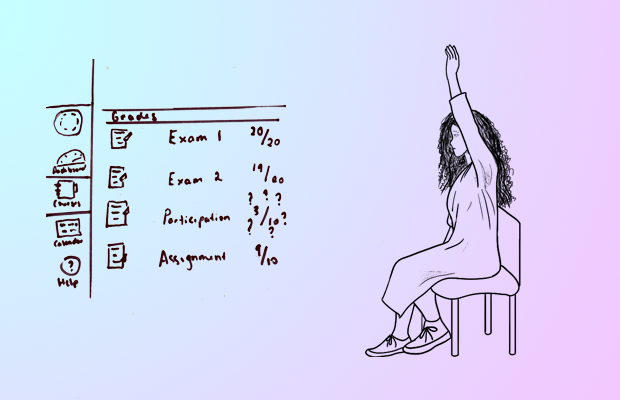Why don’t you just speak up?
Considering the case against class participation marks
“White bodies are comfortable as they inhabit spaces that extend their shape”
– Sara Ahmed, A Phenomenology of Whiteness
Class participation mark systems, used in a range of USyd subjects, allow tutors to assess the performance of students in general class discussions. Generally, they are considered to be effective in assessing the effort a student has put into learning the week’s content.
However, what often isn’t considered is the ways in which class participation unduly disadvantages students of colour.
Class participation marks are just one way in which university systems extend and accommodate whiteness at the cost of students of colour. This is particularly the case for students of an East Asian background, who may face structural barriers in the tutorial setting.
There are many examples of teachers who cannot tell students of colour apart. In one recent, particular instance, a student of colour received lower participation marks than they had expected in their “on call week”, and as a result contacted their tutor. It was then revealed the tutor had mixed up their marks with another Asian student who was also “on call” that week. Had they not contacted their tutor, the error would have gone unnoticed. Even in this specific course alone, this incident was not anomalous. Just a week later, a different tutor confused two students of colour who were “on call” in their class.
How can one’s contributions be fairly valued and marked when their tutor can’t even recognise them? The experience of students of colour is a frustrating one: hours of studying feel as if they have gone to waste merely because they remain invisible to the white structures in Australia. Naturally, the cost students of colour bear, works to the advantage of their white counterparts as tutors refuse to challenge the boundaries of their own cultural comfort zone. Somehow, the multitude of white students with common white names in a class are clearly etched into the minds of those marking class participation.
The problem of course can’t be reduced to individual incidents. Rather, individual incidents collectively demonstrate how institutions more broadly affirm some peoples’ ways of being over that of others. Without generalising or engaging in some sort of victimisation, it’s important to highlight that there may be several reasons as to why students of East Asian backgrounds may be structurally disadvantaged in the participation marks system. These observations have been detailed and affirmed by Li and Jia’s research on East Asian student’s participation patterns in their study ‘Why Don’t You Speak Up?’, and several interviews with different USyd students.
East Asian cultures place immense emphasis on principles of respecting one’s elders and not questioning their authority, acknowledging that they have more wisdom and knowledge. These values shape the general classroom structure of East Asian schools, which focus more on the teacher’s knowledge and authority in educating students rather than engaging in a discussion where the teacher and students may be viewed as equals. In Li and Jia’s study, many international East Asian students stated that they were not used to the class participation in American classes because ‘what they expected was to be good listeners in class and learn as much as they could.’
The respect for elders is also translated into the value of showing politeness and respect to other students. This is not to say that other students do not also respect fellow peers, but rather to illustrate the deep-rooted cultural ethos of respect embedded in East Asian cultures. This manifests in the way that students of East Asian cultures tend not to talk over, interrupt or talk before other students do, although some of these qualities may be necessary to thrive in the participation mark system. Thus, those who find it difficult to talk without being prompted or putting their hand up tend to perform worse than other students who seem confident jumping in to talk.
Li and Jia’s study also observes that East Asian students seem to have high anxiety levels about simply talking in class, which inhibits their participation. Although it is difficult to pinpoint a specific, tangible cause, it is true that East Asian students are generally afraid of making mistakes. Thus, we tend to not ask questions and try to solve problems ourselves, even when we could ask for help because for some reason we are afraid of being wrong in front of others and thus want to make sure our answer is right before we say it. Many of those interviewed affirmed a reticence to contribute to class discussion unless they were certain of their answers. This is a trend that may stem from important cultural ethos and is supported by the fact that some students have the social confidence to speak up whilst others don’t – these ‘others’ tending to be students of colour.
These trends, of course, are exacerbated for international students who may already be self-conscious and shy about their English. Many tutors dismiss the contributions of international students in their classes by nodding and pretending to understand what they are saying even when they don’t. But it is difficult, because on the other hand having a tutor interrupt to ask ‘can you repeat what you said?’ may be necessary for them to clarify and allocate an appropriate mark, but can be so off-putting for somebody who is already nervous about speaking in a language that isn’t their first. This is especially true given the expectation to speak fluently in such a short time – if the tutor asks a question, students have to contribute immediately, otherwise someone else will speak up first.
Most importantly, however, East Asian students will be more willing and able to participate in class when the context makes them feel comfortable to do so as Li and Jia explain. In my opinion, a better way to conduct class participation would be assessing presentations, rather than general discussions. Presentations involve an equal amount of preparation and effort, but actually, guarantee a designated time for all students where they can demonstrate their knowledge. In particular, it facilitates a greater level of confidence, especially for international students, because they can practice what they are going to say. The visual element of a presentation aids a tutor’s understanding of a student’s knowledge without cutting them off or interrupting them for clarification, or at worst dismissing their contributions.
But the issue of tutors still not understanding international students may exist to some extent in presentations. Thus another method which could be implemented either as an alternative or in conjunction is the facilitation of discussion threads on canvas which require students to present their thoughts before and/or after the tutorial. A similar method was used in a 1st year Sociology course where students were required to post their answers to the ‘question of the week’ using the given material and sources. This method could ensure students are given a designated space to demonstrate their knowledge and allow for them to spend as much time as they need in drafting their response, whilst also minimising the pressure of speaking in a limited time that unfairly impacts international students.
Changes must be made to ensure that all students’ contributions are being fairly acknowledged in the current class participation system. Some simple improvements would involve making student name cards in class, releasing participation marks in all subjects so that students can raise enquiries if something seems wrong, and implementing a more accessible way of reporting issues such as an anonymous online form so that concerns may be raised without the difficulties of having to email and chase down multiple people. The student mentioned at the beginning of this article has not received any meaningful response regarding the incident that occurred, and sothus it is unclear that any action will be taken despite the sheer unprofessionalism and racist behaviour that occurred.
Given the fact that so many similar incidents go unreported or are not acted upon, it’s obvious that we need to have better discussions on these issues. Both to validate the experiences of students of colour, and to make sure something is actually done. As students of colour we shouldn’t self-doubt and self-blame but rather realise and point out that this is a problem in the university system, external of ourselves. That will make all the difference.





